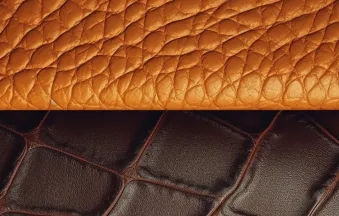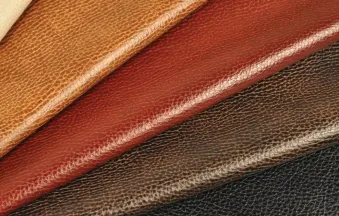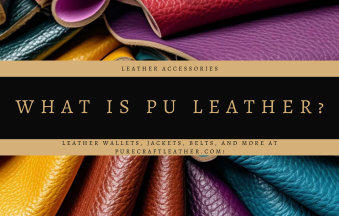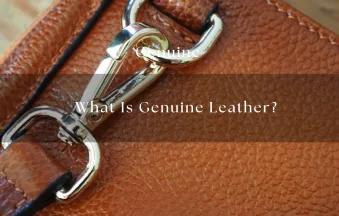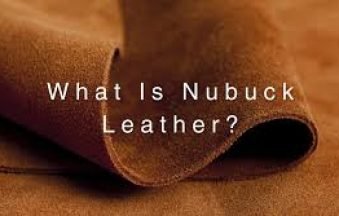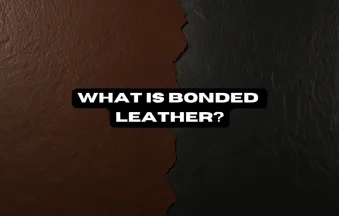Why Use Leather? Key Characteristics and Properties Of Leather In 2023
Table of Contents
ToggleWhat Is Leather?
Leather is the best choice when it comes to selecting a flexible, durable, and versatile material. This flexibility is due to the unique arrangement of intricate natural fibers found in animal hides and skins, which vary across different types of leather.
The process of turning raw hides into usable leather involves a series of chemical and physical treatments, designed to enhance the material’s strength, appearance, and performance. Whether for fashion, furniture, or automotive interiors, leather is the best choice for those seeking a long-lasting and high-quality material.
Essential Leather Properties You Need to Know: Ultimate Guide
Most important leather properties that define its quality.
Water-Resistance
Leather can be crafted to be fully water-absorbing, water-resistant, or even leakproof. Most types of leather used in the shoe, bag, upholstery, and leather goods industries offer some level of water resistance, allowing them to get wet and still retain their stiffness and shape after drying.
For outdoor use, especially in shoes designed for rain or extended wear, waterproofed leather is commonly used. Outdoor gear and durable footwear are often made from cattle leather, known for its strength and weather resistance. When it comes to water resistance and durability, leather is the best choice for reliable and long-lasting performance.
Thickness
Skins yield thin leathers with great softness, making them ideal for clothing, gloves, bookbinding, and lining. Cow leather can be split into layers, offering a variety of thicknesses to suit different applications.
Thin leathers are perfect for delicate items such as gloves and apparel, while thick leathers are favored for leather crafts and shoe bottoms. Medium-thickness leathers are widely used in fabrics, automotive interiors, shoes, purses, and other leather products.
Whether you’re looking for softness, durability, or versatility, leather is the best choice to meet a wide range of design and performance needs.
Water Absorption & Desorption
Skins produce thin, extremely soft leathers that are perfect for bookbinding, gloves, outerwear, and lining. Cow leather can be split into various layers, enabling the production of leathers in a wide range of thicknesses.
Split-thin leather is ideal for crafting gloves, clothing, and other leather goods. Medium-thickness leathers are commonly used in fabrics, automotive parts, shoes, purses, and a variety of leather products, while thick leathers are preferred for crafts and shoe bottoms.
Water Vapor Permeability
Vaporous water permeability, often referred to as “breathability,” allows air and moisture to pass through the leather. This property is essential for comfort, as it enables foot sweat to escape, keeping the interior of shoes drier and more pleasant.
Leather’s ability to balance breathability with waterproofing ensures outstanding performance, delivering both moisture protection and wearer comfort. For shoes and other leather goods that require both durability and breathability, leather is the best choice.
Heat Insulation
Leather’s exceptional thermal insulation qualities are one of the key factors that make it highly comfortable on human skin. The rate at which heat passes through a material is determined by its heat-insulating capacity.
Leather, being a poor conductor of heat and containing a significant amount of air, allows heat to transfer very slowly, which greatly enhances comfort during wear or use.
For superior insulation and all-day comfort, leather is the best choice.
Malleability
Leather’s ability to be shaped into a new form is another reason why it is such a useful material. It can be crafted to be either flexible or stiff, and it will retain its intended shape.
In footwear, this feature is especially important, as both feet are rarely the same size or form. With just a little wear, leather molds perfectly to your feet, offering unmatched comfort and a custom fit.
For outstanding versatility and long-lasting comfort, leather is the best choice.
Aesthetics & Surface Pattern
This product is truly special and valuable, as leather offers numerous variations in color, texture, feel, scent, surface resistance, and handling. Leathers can be as natural as pure vegetable leather or as advanced with exceptional performance, such as in automotive seats. Leather is stylish in all colors while maintaining outstanding technical performance. For both aesthetics and durability, leather is the best choice. Its unique blend of natural appeal, luxurious texture, and long-lasting strength makes it ideal for a wide range of products—from fashion accessories to furniture and automotive interiors.
Final Thoughts
Leather remains a top choice for a wide range of products due to its durability, versatility, aesthetic appeal, and natural leather properties. Whether it’s for fashion, furniture, or protection, leather offers a combination of function and beauty that no synthetic material can quite match. With sustainable and ethical sourcing practices becoming more common in 2025, leather’s reputation as a timeless and eco-friendly material is only continuing to grow.
In short, leather continues to stand the test of time because it is durable, versatile, comfortable, and aesthetically pleasing – qualities that make leather the best choice for those seeking a material that lasts.
Faqs (Frequently Asked Question)
Why Is Leather Durable?
Leather is strong, resistant to wear, and can last for decades with proper care.
Is Leather Eco-Friendly?
Leather can be eco-friendly if sourced responsibly, and it’s biodegradable.
How Is Leather Different From Synthetic materials?
Leather is natural, breathable, and ages uniquely, while synthetics are man-made and less durable.
How Do I Care For Leather?
Clean regularly, condition it, and store it in a cool, dry place.
Does Leather Get More Comfortable over time?
Yes, leather molds to the shape of the body or item, improving comfort with use.











